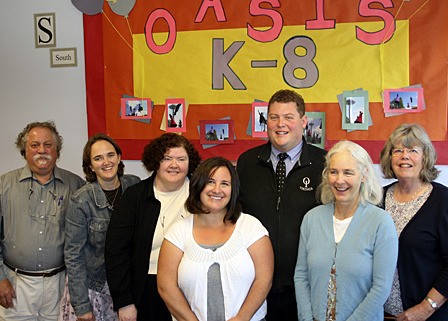Matthew Laslo-White enjoys two subjects: violin and magic.
Because he sets his own curriculum under the Orcas School District’s OASIS program, that’s exactly what he studies – in addition to reading, writing, and arithmetic.
“I am trying to meet the educational needs of our child, whose learning style is better suited for one-on-one learning,” said his mother Donna Laslo, who is also head of the OASIS site council, a parent group. “It’s child-directed learning, so it is subjects Matthew is very passionate about. And it is tailor-made for me – a parent who is interested in education.”
The OASIS K-8 school, now in its ninth year, is an alternative educational program designed to help parents who want a home-school or alternative education option for their children. This year, there are a record number of participants: 220 students, with 20 on a waiting list. Last year, 100 kids were enrolled in OASIS. Around 75 percent of this year’s student body lives on the mainland.
“For the first time, we have more out of district OASIS kids than San Juan County kids,” superintendent Barbara Kline said. “(All that is) required is that every student enrolled in our district is from Washington state. They (the OASIS students) are all over the Washington map this year.”
How it works
OASIS students enroll in Orcas School District just like everybody else. They can take as many or as few on-site classes as they like as well as participate in sports programs. The main difference: their educational plans are devised by their parents and teachers and taught outside the classroom. Principal Kyle Freeman and instructor Lynn Perry run the K-8 program, with assistance from a handful of teachers. Due to the increased enrollment, the school has had to hire additional staff.
“And it still may not meet our need,” Freeman said.
Perry says the school has capped the program at its current number, although Orcas students are always given priority over mainland kids.
“We want to be able to serve our families well,” Perry said. “The student/teacher ratio is low enough that we can develop relationships. We help families align with state goals and feel comfortable.”
The state gives Orcas school funds for every student enrolled in the OASIS program. Kline says the amount of money depends on the grade level, but on average, the school receives $6,000 per student. Most of the money goes towards supporting the OASIS students’ education; between 15 and 20 percent goes back into the district.
“One of the things I tell the teachers: this is not a way to get rich,” Kline said. “It’s a way to be sustainable, and provide educational opportunities for students around the state and improve our education for local students.”
Laslo says it is a win-win situation: Orcas School gets a small financial boost that can be used for local students, while home-school kids receive money for materials and receive curriculum assistance.
“We partner with the school and ask for resources,” Donna said. “For example, I could say to them: ‘Matthew is having trouble with math. What are some tools to help me handle math better?’ OASIS is an actual school, just like the regular brick and mortar school. The difference is that all the learning takes place at home, but you have a teacher who is overseeing what you do.”
For Laslo-White, the OASIS program has allowed him to be the captain of his educational journey. He gets to explore his favorite subjects, in addition to the state’s requirements.
“Everyone understands that kids have a different way of learning, and all styles need to be acknowledged,” Laslo said. “We are making a choice as a family to do this – this is no small feat. It’s a full-time job, and it’s not for the faint of heart. But if you decide to do it, there is a lot of support in this community.”
Each family that participates leaves behind their curriculum for future families to use. The school has created a resource library and is putting the finishing touches on a student/parent handbook that provides detailed program guidelines. Kline says OASIS is developing a stellar reputation among the home-schooling families, both on-island and off.
“The parents who are working with their students at home talk to each other,” she said. “Parents talk about what are the best schools to work with, and Orcas has been getting a good name.”
Laslo is confident the program will blaze a trail for future alternative education schools.
“Our hope is to develop OASIS classes on-site for students, within the structure of the school,” Laslo said. “We are shifting the future of education. It’s innovative and highly creative for those who want to do that. It could possibly pave the way for an integrated education system that will meet a lot of people’s needs.”
OASIS high school
Superintendent Kline and teacher Jill Sherman oversee the high school component of OASIS, which was launched in 2007. It differs from the K-8 school, as most of the students live on Orcas and attend classes on campus. Its purpose is to provide an alternative learning environment to high schoolers, some of whom may otherwise not graduate. The students can complete their high school diploma or GED on a more flexible timeline. There are 30 students enrolled for 2010-11, the same number as last year.
“We started the OASIS high school because there were some students we were not being successful with, and we weren’t able to hold on to them during that fifth year (of high school),” Kline said. “So we realized that if we changed the time requirements, it would take a huge burden off them. When we did that, we increased the graduation rate, and for specific students, we were really able to help them graduate. The personal stories of growth and change are phenomenal. It’s wonderful to hear in their voices the sense of success when they graduate.”



